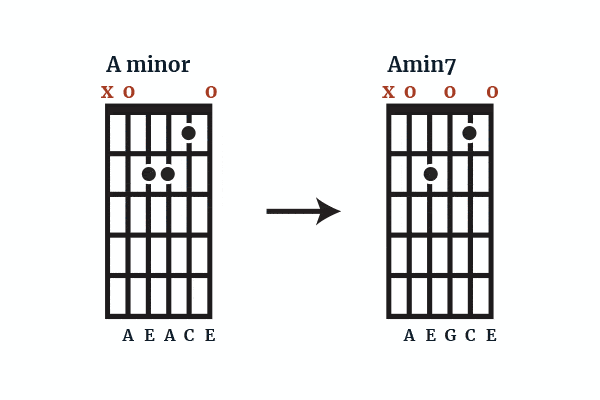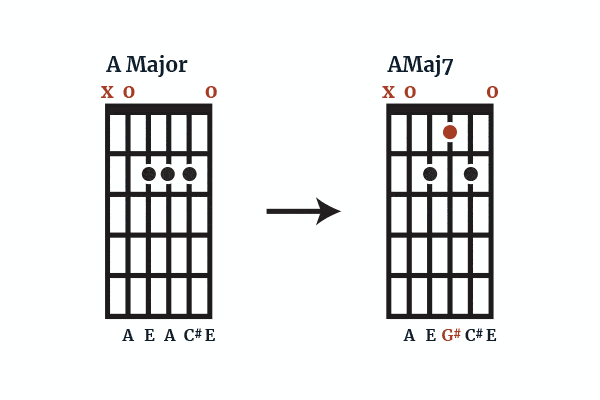Ever come across a chord written like this ø7 or perhaps m7b5 or even -7b5 and wondered what it was? It’s a half-diminished 7th chord also known as a minor 7 flat 5.
Here’s a quick rundown: Half diminished 7th chords (aka minor 7 flat 5 chords) are minor 7th chords with a flattened 5th aka diminished 5th interval. If using scale degrees the formula is 1, b3, b5, b7. They are often used as a passing chord to connect two chords. In major keys, the half-diminished 7th chord can be used as the vii chord. In minor keys, it can be used as chord ii.
If you’re keen to learn more stay tuned, in the following article we’re going to discuss how they are built, how to play them, and finally how to use them in a musical context.
However, if you are looking for more of an overview of 7th chords in general, click the link above.
What Do Half Diminished 7th Chords Sound Like?
Half diminished 7th chords are typically not chords you would stay on for too long, they are more commonly used to connect chords. They tend to sound unstable as the perfect 5th interval, which as the name suggests is ‘perfect’ or consonant (the opposite of dissonant) is flattened by a semitone. This introduces dissonance, making it more ambiguous than a typical major or minor chord, sounding neither happy nor sad.
How To Build Half Diminished 7th Chords Using Intervals
If you already have an understanding of guitar theory, the clue is in the alternative name used for the chord: minor7 flat 5. If you are already familiar with minor 7 chords, you can probably work out from the descriptive name that a minor 7 flat 5 (aka half-diminished 7th chord) is a minor 7th chord with its perfect 5th interval flattened a semitone, making it diminished.

Why is it diminished and not minor?
While major tones when lowered in pitch a semitone form minor intervals and vice versa, perfect intervals, e.g. the perfect 5th, when lowered a semitone are referred to as diminished. If raised a semitone they are considered augmented.
The table below shows the 13 different intervals used in music, including the unison (same notes) and octave (13 notes). The highlighted intervals, semitones, and notes form an A half-diminished 7th chord or minor 7 flat 5 chord.
| Intervals | P1 | m2 | M2 | m3 | M3 | P4 | dim5 | P5 | m6 | M6 | m7 | M7 | P8 |
| Semitones | 0 | 1 | 2 | 3 | 4 | 5 | 6 | 7 | 8 | 9 | 10 | 11 | 12 |
| Notes | A | A♯ | B | C | C♯ | D | D♯ | E | F | F♯ | G | G♯ | A |
Why is it called Half-Diminished?
It’s close but not a true diminished chord due to the flattened 7th scale degree. A diminished 7th chord is built by stacking 4 minor thirds on top of each other e.g. 1, ♭3, ♭5, ♭♭7.

Both contain diminished triads within their structure e.g. the first three notes make a diminished triad. However, because the chord contains a flattened minor 7th interval, which is a major third above the flattened fifth it is referred to as half-diminished 1, ♭3, ♭5, ♭7.
Building Half Diminished 7th Chords using Scale Degrees
As mentioned above, the formula for building a half-diminished 7th chord is 1,♭3,♭5,♭7.
Here’s an example of an A half-diminished 7th chord (Aø7 or Am7♭5) taken from the A major scale (A, B, C♯, D, E, F♯, and G♯).
As you can see, we include the root, a flattened third (lowered from C♯ to C), a flattened fifth scale degree (E lowered to Eb) just like a diminished triad, along with the flattened 7th scale degree of G (lowered from G#).
| A | B | C | D | E♭ | F | G |
| 1 | 2 | ♭3 | 4 | 5 | 6 | ♭7 |
How to Play Half Diminished 7th Chords
There are three useful, moveable shapes we can use for playing half-diminished 7th chords. The first is rooted on the low E string, the second on the A string, and the third on the D string allowing for three different voicings each expressing the chord in different ways.
In the chord chart below I could have left the 5th string open (A) as this would add a second root note of the chord, but as this is a moveable shape it’s best to learn it without the open string, as this gives you the ability to play half-diminished 7th chords across the neck.
You can either clawhammer pick the chord, bypassing the 5th string, or mute the 5th string with the tip of your finger fretting the 6th string.

The second common shape is rooted on the A string. The trick here is to mute the two e strings. You can use the index finger fretting the 5th string to press against the 6th string effectively muting it if required.

Lastly, the third shape which is rooted on the D string expresses the chord slightly differently again, with a little more high-end shimmer.

As these are all moveable shapes, provided you know the layout of notes on your fretboard you should have any trouble playing half-diminished 7th chords right across the neck utilizing these simple shapes.
How To Use Half Diminished 7th Chords On The Guitar
Now that we know some useful shapes, how do we incorporate half-diminished chords into our playing?
We can replace any diminished chords in our chord scale with half-diminished 7th chords.
In major keys, this means we can replace the vii chord.
| I | ii | iii | IV | V | vi | vii° |
| tonic | supertonic | mediant | subdominant | dominant | submediant | Leading Tone |
| Amaj | Bmin | C#min | Dmaj | Emaj | F#min | G#m7b5 |
In minor keys, this means we can replace the ii chord.
| i | ii° | III | iv | v | VI | VII |
| tonic | supertonic | mediant | subdominant | dominant | submediant | Leading tone |
| Amaj | Bm7b5 | Cmin | Dmin | Emin | FMaj | GMaj |
Half diminished chords are often used to introduce tension before resolving to the tonic chord. As a result, they have often been used a passing chord before resolving to the I chord in major keys.
Summary
Half diminished or minor 7 flat 5 chords are a useful chord, that can provide a little more sophistication to an existing chord progression. The 3 moveable shapes demonstrated above aren’t overly difficult to learn and as they are moveable can be played all over the neck.


![7th Chords [Complete Guide] 8 What are 7th Chords](https://theacousticguitarist.com/wp-content/uploads/2021/09/what-are-7th-chords.gif)
